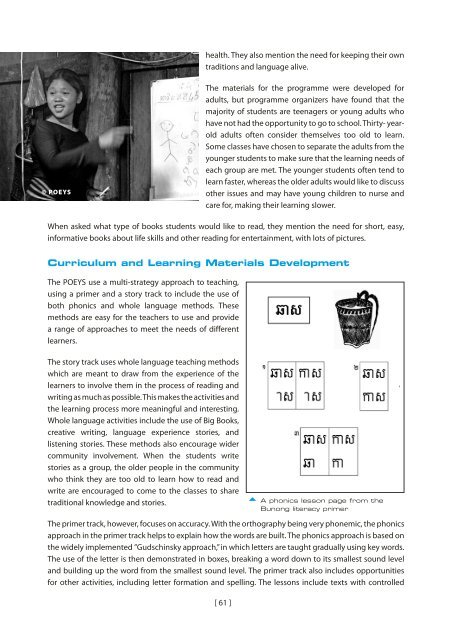Mother Tongue-based Literacy Programmes: Case Studies of Good ...
Mother Tongue-based Literacy Programmes: Case Studies of Good ...
Mother Tongue-based Literacy Programmes: Case Studies of Good ...
You also want an ePaper? Increase the reach of your titles
YUMPU automatically turns print PDFs into web optimized ePapers that Google loves.
health. They also mention the need for keeping their owntraditions and language alive.© POEYSThe materials for the programme were developed foradults, but programme organizers have found that themajority <strong>of</strong> students are teenagers or young adults whohave not had the opportunity to go to school. Thirty- yearoldadults <strong>of</strong>ten consider themselves too old to learn.Some classes have chosen to separate the adults from theyounger students to make sure that the learning needs <strong>of</strong>each group are met. The younger students <strong>of</strong>ten tend tolearn faster, whereas the older adults would like to discussother issues and may have young children to nurse andcare for, making their learning slower.When asked what type <strong>of</strong> books students would like to read, they mention the need for short, easy,informative books about life skills and other reading for entertainment, with lots <strong>of</strong> pictures.Curriculum and Learning Materials DevelopmentThe POEYS use a multi-strategy approach to teaching,using a primer and a story track to include the use <strong>of</strong>both phonics and whole language methods. Thesemethods are easy for the teachers to use and providea range <strong>of</strong> approaches to meet the needs <strong>of</strong> differentlearners.The story track uses whole language teaching methodswhich are meant to draw from the experience <strong>of</strong> thelearners to involve them in the process <strong>of</strong> reading andwriting as much as possible. This makes the activities andthe learning process more meaningful and interesting.Whole language activities include the use <strong>of</strong> Big Books,creative writing, language experience stories, andlistening stories. These methods also encourage widercommunity involvement. When the students writestories as a group, the older people in the communitywho think they are too old to learn how to read andwrite are encouraged to come to the classes to sharetraditional knowledge and stories. A phonics lesson page from theBunong literacy primerThe primer track, however, focuses on accuracy. With the orthography being very phonemic, the phonicsapproach in the primer track helps to explain how the words are built. The phonics approach is <strong>based</strong> onthe widely implemented ”Gudschinsky approach,” in which letters are taught gradually using key words.The use <strong>of</strong> the letter is then demonstrated in boxes, breaking a word down to its smallest sound leveland building up the word from the smallest sound level. The primer track also includes opportunitiesfor other activities, including letter formation and spelling. The lessons include texts with controlled[ 61 ]

















